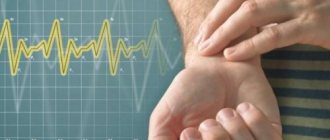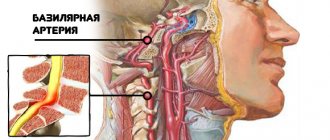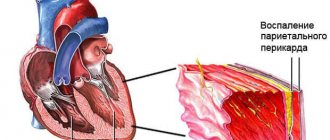It is believed that heart rate (HR) and pulse are the same concepts. But it is not so. Heart rate shows the contractions per minute of the lower parts of the heart, its ventricles, and the pulse rate is the number of dilations of the artery at the moment of blood ejection from the heart. As the blood passes through the vessels, it creates a bulge in the arteries, which can be determined by touch and, by placing two fingers on the wrist or neck, the number of beats per minute can be checked. Correspondence between heart rate and pulse rate can only be found in healthy people.
Measuring the amount of vibration of arterial walls
In order to take measurements and find out the normal pulse
it is necessary to use the palpation method in the following places:
- Armpits.
- Elbow bend.
- Wrists.
- Inner thigh.
- Carotid artery.
- Viska.
Do not measure your heart rate immediately after eating or exercising.
In the morning, when the body is at rest, you need to apply two fingers (index and middle) to the neck, thigh and temple alternately. The beats are counted for 60 seconds. You can use a stopwatch or time yourself.
You can measure the oscillation frequency using a tonometer: this device is intended not only for measuring blood pressure.
how many beats per minute
Changing the number of strokes is possible in the following cases:
- Physical stress on the body.
- Stressful situation, excitement.
- Taking medications.
- Consumption of alcoholic beverages and tobacco products.
- Change in body temperature.
If the number of vibrations becomes less than 50 beats per minute, this indicates the presence of any pathologies. As a rule, a person experiences weakness and nausea. If the number of oscillations is reduced to 35 beats, the brain begins to experience oxygen starvation. Read here and find out why your blood pressure rises.
Systolic volume
Normal values of systolic blood volume in children
The next main indicator of the functioning of the human heart is systolic or stroke volume of blood (SB, SV). It represents the volume (portion) of blood that the ventricles eject into the vessels during the systole phase. CO is an indicator that can vary depending on gender, age, and the functional state of the body. It is logical that during the physical period this figure increases, since working muscle mass must be supplied with additional blood volume.
Let's start with normal indicators of systolic blood volume in children:
- During the neonatal period, a stroke volume of 2.5 ml is considered normal;
- By the year this figure increases to 10.2 ml;
- At 7 years of age, a normal volume of CO is considered to be 28.0 ml;
- In children aged 12 years, the figure continues to increase and is 41.0 ml;
- From 13 to 16 years of age, blood volume is 59.0 ml.
Blood CO calculations
The normal values for stroke or systolic blood volume vary between children and adults. For men, this figure is 65-70 ml per systole, for women - 50-60 ml per systole. However, not all of the blood in the ventricles is released into the vessels. The resting systolic blood volume may be one-half or one-third of the total blood volume in the ventricle. This is necessary so that at the time of physical activity the ventricles have a reserve supply needed by the body.
Therefore, at the moment of physical or emotional overload, the human heart is capable of increasing the stroke volume by 2 times. Both the right and left ventricles should have approximately the same systolic volume. In other words, the portion of blood ejected by the ventricles must be the same. Blood CO can be calculated based on minute blood volume and heart rate (HRF). IOC divided by heart rate will be the systolic or stroke volume of blood.
The number of beats in the male body at rest
If you compare the number of vibrations of the arterial walls per minute in a man and a woman, the values will differ by 10 beats.
First of all, this depends on the different structure of organisms: per kilogram of body weight for a man there is 65 ml of blood, while for a woman this figure is 60 ml. This is explained by the fact that the volume of the male heart is slightly larger than the female organ.
A man's maximum oxygen consumption is also higher, and this has a direct impact on the number of contractions.
What is the normal heart rate per minute for a person
? The resting heart rate of a man in good physical condition reaches 50 beats per minute. Rarely the value may be reduced. This is normal for an athlete's heart.
How to determine pulse correctly
Most specialists measure the pulse at the wrist artery. This is due to the fact that the wrist artery passes close to the surface of the skin. In the marked place it is very convenient to independently detect and count the pulse. You can even do this for yourself.
The artery is felt on the left arm, since it is closer to the heart, and therefore the shocks of the artery walls are more distinct. You can measure the pulse on your right hand. It is only necessary to take into account that in this case it may be felt out of sync with the heartbeats and be weaker.
Ideally, the pulse in both arms should be the same for an adult. In practice, it varies. If the difference is large enough, then the cause may be problems with the cardiovascular system. If this is discovered, then it is necessary to undergo examination by a specialist.
In order to correctly count the pulse, you need to turn your left palm up. It is better to place your hand on a horizontal plane at chest level and bend your wrist slightly.
If you grab your wrist from below with your right hand, the middle finger of your right hand will feel shocks in the area of the bend of the wrist of your left hand. This is the radial artery. It feels like a soft tube. You need to press it lightly, which will allow you to better feel the shocks. Then count the number of pulsations for a minute.
This will be the pulse. Some people count their pulse for 10 seconds and then multiply it by six. We do not recommend this method, since when counting beats per second, the error increases, which can reach large values.
It is not recommended to determine the pulse using your thumb, as it is less sensitive. You can miss the impulse from the heartbeat, which also leads to errors in the calculations.
Number of beats in the female body at rest
How long does a person have a normal pulse?
? The female body is structured differently: at rest, the number of vibrations of female arteries varies from 60 to 70 beats per minute.
A woman’s pulse is influenced by hormonal levels, which change at the beginning of the menstrual cycle. In the first phase, at rest, a woman’s pulse is 10 beats per minute. This value is typical for the third phase of the cycle.
Menopause is a physiological phenomenon that is also reflected in the number of oscillations of the arteries: at rest, the number of beats reaches 80 - this is the normal number of beats per minute of the heart
. During pregnancy, the heart rate also changes: an increase in beats is observed (+10 to the average value at rest).
Heart rate depending on age
Normal heart rate
- In the prenatal period, a normal heart rate is considered to be from 120-160 heart beats per minute.
- During the newborn period (up to one month, 29 days), the normal heart rate is considered to be from 110 to 170 heartbeats per minute.
- From one month to a year, heart rate indicators range from 102 to 162 contractions per minute.
- From one to two years, the heart rate level decreases to 154 beats at the upper limit and 94 beats at the lower limit.
- The next age period is from two to four years. The normal heart rate for a child at this age is 90 - 140 heartbeats per minute.
- At four to six years old, normal heart rate showed - from 86 to 26 heartbeats per minute.
- At six, seven and eight years old, 78-118 beats per minute is normal for a child.
- From 8 years to 10 years, the normal heart rate ranges from 68 to 108 beats per minute.
- At 10-12 years of age, the normal limit for children is between 60 and 100 beats per minute.
- At 12-16 years old, this indicator decreases to 55 beats per minute at the bottom and 95 beats per minute at the top.
- From 16 to 50 years, the boundaries of normal heart rate are within 60-80 beats per minute.
- From 50 to 60 years of age, normal heart rate is considered to be from 64 to 84 beats. per minute in an adult patient.
- From sixty to eighty years of age, normal heart rate is between 69 and 89 beats per minute.
Determination of heart rate on the carotid artery
Heart rate can be determined by palpation of the radial or carotid artery. Determination of the pulse on the radial artery in a healthy person corresponds to the heart rate. Palpation of the radial artery is performed by pressing the pads of the four fingers of the hand on the outer (lateral) surface of the hand. The thumb should be on the back of the hand. This method of determining the pulse should not cause difficulties.
If the radial artery lies deep or subcutaneous fat is pronounced, you can try to determine the pulse on the carotid artery. However, when determining the pulse in this way, you should be careful, since strong pressure can cause a decrease in blood pressure. The place for determining the pulse on the carotid artery is the lateral surface of the neck. It is necessary to turn your head as far as possible to the side. Due to this, an oblique contour of the neck muscle appears on the lateral surface of the neck.
By drawing a line from the upper edge of the thyroid cartilage (Adam's apple) to the anterior edge of this muscle horizontally, you can feel the pulsation of the carotid artery, after which you can determine the pulse. It is worth remembering that the pulse may not always coincide with the heart rate. This phenomenon is called pulse deficit. The volume of blood ejected by the ventricles does not reach the peripheral arteries. In such cases, the number of heart contractions exceeds the pulse rate in the peripheral arterial vessels. Pulse deficiency can be observed with atrial fibrillation and extrasystole.
Possible reasons for deviations of the pulse value from the established norm
The most common reasons affecting the change in the number of strokes are:
- Physical stress on the body.
- Regular exercise.
- Sexual intercourse.
- Feeling very hungry.
- Oversaturation of the body.
- Stressful situation.
- Drinking alcoholic beverages.
- Drug use.
- Use of tobacco products.
- The beginning of a woman's menstruation.
- A course of massage or other procedures that relax the body.
reasons for abnormal heart rate
Minute blood volume
Blood IOC calculations
The minute volume of blood is the portion of blood that the ventricles eject into the vessels per unit time. In other words, it is the product of systolic or stroke volume and heart rate. IOC, like CO or SV, depends on age, gender, resting state or load:
- For newborns, normal IOC is within 340 ml;
- For children aged one year it is 1250 ml;
- At 7 years, the IOC is 1800 ml;
- In children aged 12 years, the IOC is 2370 ml;
- By the age of 16, the IOC indicators for girls are 3.8 l, for boys - 4.5 l;
- In adults, the normal IOC value is 4-6 liters.
With increasing load on the cardiovascular system, the IOC can increase to 30 liters per minute. In people involved in sports, IOC indicators can reach 40 liters per minute under conditions of physical activity.











